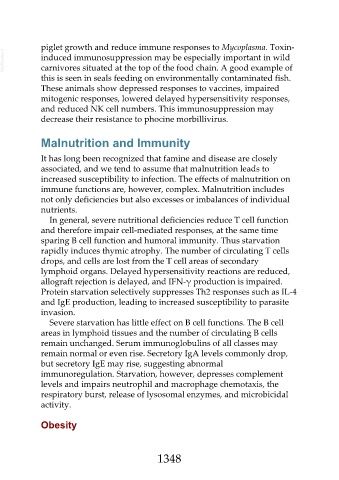Page 1348 - Veterinary Immunology, 10th Edition
P. 1348
piglet growth and reduce immune responses to Mycoplasma. Toxin-
VetBooks.ir induced immunosuppression may be especially important in wild
carnivores situated at the top of the food chain. A good example of
this is seen in seals feeding on environmentally contaminated fish.
These animals show depressed responses to vaccines, impaired
mitogenic responses, lowered delayed hypersensitivity responses,
and reduced NK cell numbers. This immunosuppression may
decrease their resistance to phocine morbillivirus.
Malnutrition and Immunity
It has long been recognized that famine and disease are closely
associated, and we tend to assume that malnutrition leads to
increased susceptibility to infection. The effects of malnutrition on
immune functions are, however, complex. Malnutrition includes
not only deficiencies but also excesses or imbalances of individual
nutrients.
In general, severe nutritional deficiencies reduce T cell function
and therefore impair cell-mediated responses, at the same time
sparing B cell function and humoral immunity. Thus starvation
rapidly induces thymic atrophy. The number of circulating T cells
drops, and cells are lost from the T cell areas of secondary
lymphoid organs. Delayed hypersensitivity reactions are reduced,
allograft rejection is delayed, and IFN-γ production is impaired.
Protein starvation selectively suppresses Th2 responses such as IL-4
and IgE production, leading to increased susceptibility to parasite
invasion.
Severe starvation has little effect on B cell functions. The B cell
areas in lymphoid tissues and the number of circulating B cells
remain unchanged. Serum immunoglobulins of all classes may
remain normal or even rise. Secretory IgA levels commonly drop,
but secretory IgE may rise, suggesting abnormal
immunoregulation. Starvation, however, depresses complement
levels and impairs neutrophil and macrophage chemotaxis, the
respiratory burst, release of lysosomal enzymes, and microbicidal
activity.
Obesity
1348

